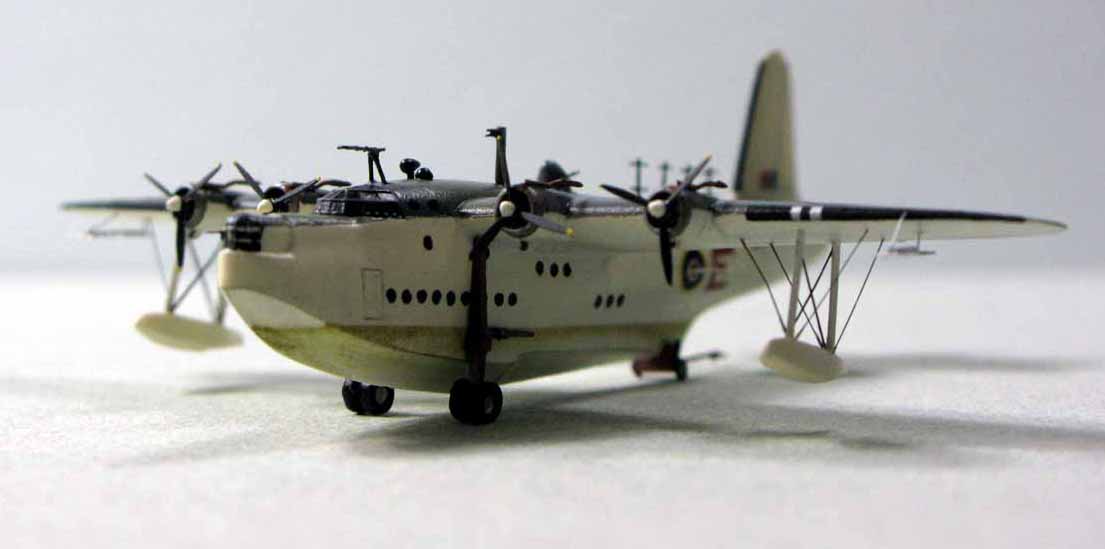by Stephen Allen

1/350 Short Sunderland (L’Arsenal)

L’Arsenal has produced a simple resin kit of the Sunderland in 1/350 scale, a perfect accompaniment to dioramas, or for comparison with naval vessels in this scale.
The parts count is low, consisting of fuselage, wing and mid section with the mid upper turret moulded in, tail section, vertical fin and the two wing floats. Photo-etch is supplied for the float struts and propellers. A good basic decal sheet supplies roundels and fin flashes that can be used to model an early, mid or late war aircraft. If you want to build a particular aircraft you will need to find code letters and serial numbers from another source.
All the parts are well-moulded and free from flaws. I found that the wing mid-section needed a little sanding before it would sit flush with the remainder of the fuselage, but that was all that was needed for a good fit. Frame detail for the cockpit and turrets is quite clearly defined and portholes are represented by shallow recesses. I used a little Tamiya putty thinned with plastic cement to fill gaps.
In terms of accuracy the little aircraft certainly captures the lines of the Sunderland well, though you should note that the knife edge vertical step and mid-upper turret means that the aircraft is technically a Mk II. To build a Mk III, the most produced version, or a Mk V, you will need to fair in the step, which can be easily done with a little putty. To build a Mk I, just remove the mid-upper turret (or depict a modified Mk I as I did).
I built the kit as T9114, aircraft ‘E’ of 461 Sqn RAAF, based at Pembroke Dock. In May 1943 this aircraft landed in the Bay of Biscay to rescue the crews of a downed Whitley and another Sunderland. The aircraft was unable to take off again with the additional crew on board, and the Free French destroyer La Combattante came to the rescue, taking the extra crew off and attempting to tow the Sunderland. After four hours of being dragged behind the destroyer, and nearly dragged under in the process, the pilot decided to risk a take off. After a long run in rough water the Sunderland finally made it in to the air but with a massive hole ripped into the fuselage by the seas. Unable to attempt another water landing, the aircraft was instead landed at Angle airfield, where it came to rest with the port float ripped off but otherwise undamaged. Some accounts suggest that the aircraft was subsequently repaired and returned to service but I have been unable to confirm this. The Australian War Memorial has a series of photos showing the aircraft on the water with La Combattante, and the aftermath of the landing at Angle Airfield. These were my principal references, and I used the ‘Warpaint’ Sunderland book for general detailing – it has good plans of the Sunderland in 1/72 scale.
For those interested T9114 was a Mk1, but had clearly been modified/repaired at some stage, as it sported a mid-upper turret at the time of this incident. It carries the characteristic aerial arrays of the early versions of ASV radar. These were all cut from convenient bits of photo etch railing or grid.
I expanded on the basic kit by adding extended exhausts, home made beaching gear, ASV radar aerials from photo etch, machine gun barrels and bracing wires to the floats. The paints are WEM, and depict the mid-war disruptive scheme of Extra Dark Sea Grey and Dark Slate Grey over white undersurfaces. I used filters to build up a patchy and streaked appearance, and used oil colours to add the gunge along and below the waterline. The kit decals were modified to show a duller red for the roundels and, yes, the Type B roundels on the wings have the correct non-standard proportions of red and blue for this aircraft. The serials are from a Microscale railway gothic sheet. Portholes were punched out of a black decal sheet.
This was a fun little build, and I look forward to building a Catalina to go with it. If only Jacques would consider adding a VLR Liberator to his growing range of small aircraft!
